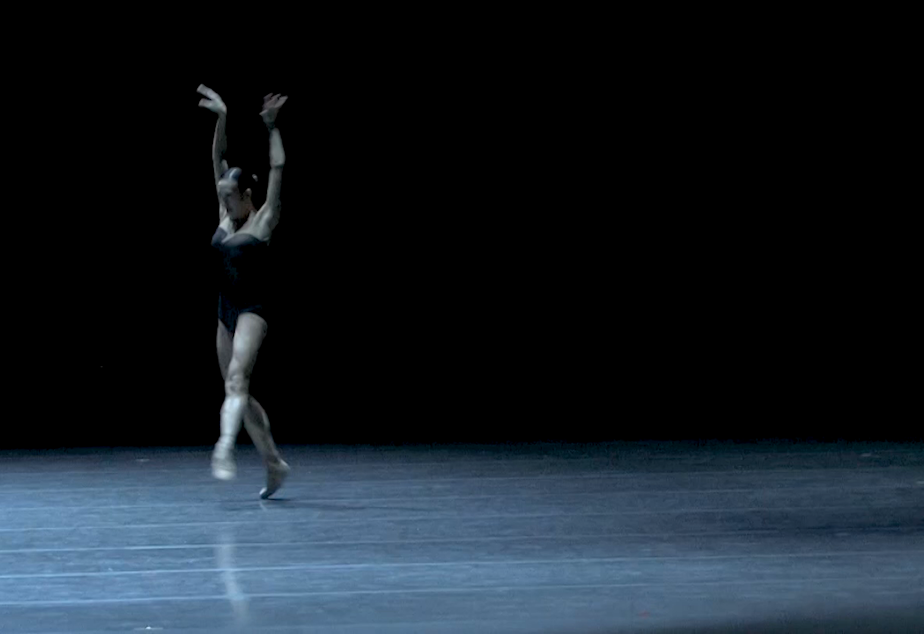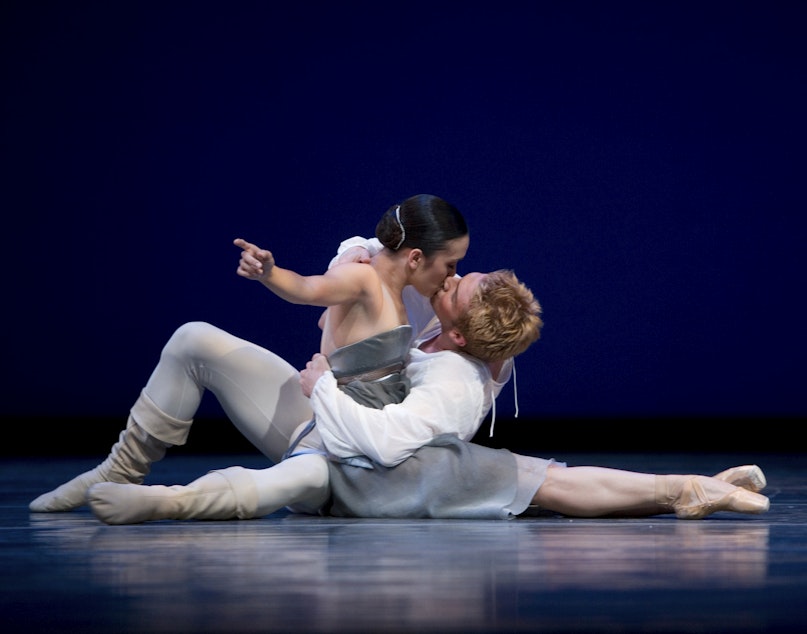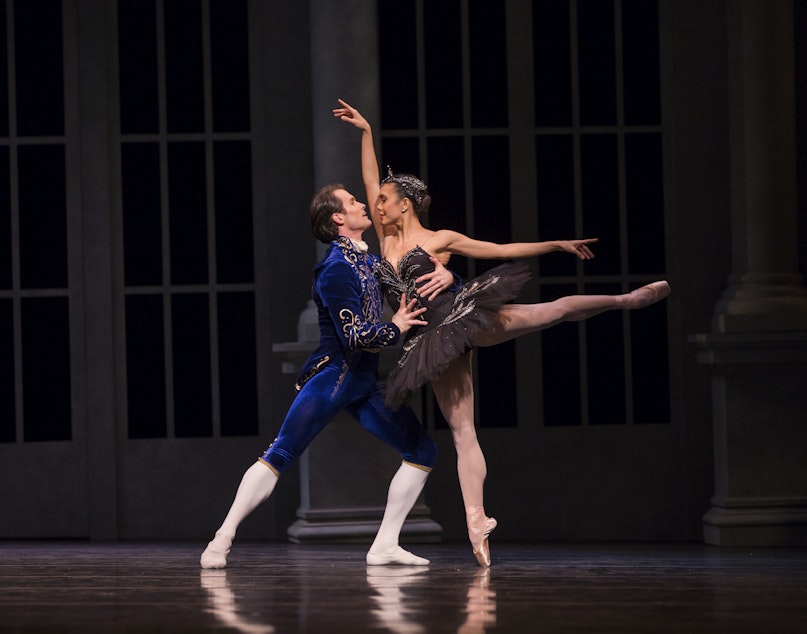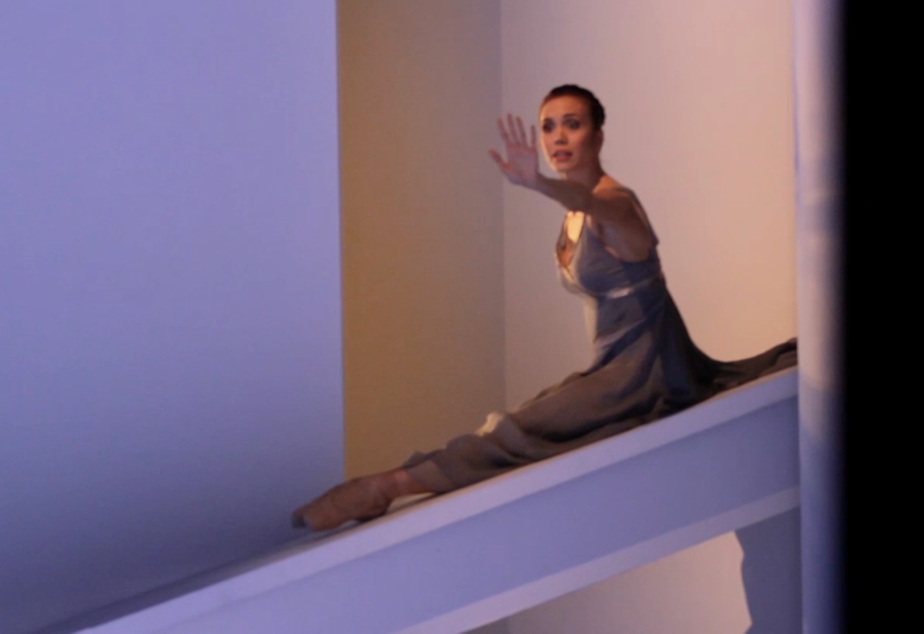If she isn't dancing, who is Noelani Pantastico? Even she isn't sure

Mid-May in Seattle is often gray and rainy, the kind of weather that makes you want to stay in bed.
But on a dreary Monday morning, four Pacific Northwest Ballet company members had no time to wallow under the covers. Instead, they were stripped to sleeveless leotards, rivulets of sweat oozing down their necks as they moved across the studio floor.
The women, in tutus and pointe shoes, pivoted from flat feet up to their toes in a fast-paced series of twirls across the room; the men leapt around them in grand jetés to the nonstop rhythm of a Tchaikovsky concerto. When the last chord of music faded away, all four dancers succumbed to fatigue, bending from the waist to gasp for breath. This was their first run-through of the demanding finale to George Balanchine’s 1947 ballet “Theme and Variations.” Featured roles in pieces like this are coveted and go to the company’s best dancers.
Missing from the studio on this particular morning: longtime principal dancer Noelani Pantastico. She’d been scheduled to perform, but a last-minute injury forced her to step out two weeks before the production. It was her second injury in this artistic season.

 28 secs
Noelani Pantastico in “Empire Noir,” choreography by David Dawson.
28 secs
Noelani Pantastico in “Empire Noir,” choreography by David Dawson.
Sponsored
Pantastico has been a professional ballet dancer for more than 20 years, most of that time with PNB. Now age 39, she knows she doesn’t have many years left in this career. When it comes to physical demands — and punishments — ballet is much more like professional football than other art forms. Most ballet dancers retire from their all-encompassing careers before they hit 40.
Six months ago, Pantastico wondered if her time had come. She was sidelined by damaged cartilage in her ankle and wasn’t sure she had the mental discipline to get back to the physical shape she needed to perform.
“I was doing everything, PT and such, but there was a part of me that felt I should start letting go,” Pantastico says. “I almost didn’t want to put up a fight. I almost wanted it to take me down.”
Two of Pantastico’s colleagues, fellow principal dancers Jonathan Porretta and Rachel Foster, had announced their impending retirements, but Pantastico decided she wasn’t ready to join them. For her, ballet has always been more than a career; the studio was a source of positive reinforcement, the place that gave her life meaning. The prospect of leaving a profession that has defined her is terrifying. Who will she be without ballet?
“I worry,” Pantastico sighs. “I worry because what it brought to me was so significant, what it was doing for me as a kid. I worry that if I’m not dancing, will I survive?”

Sponsored
P
antastico was the middle of six children, born to three different men and the same mother. Her father, her mother’s second husband, died of esophageal cancer when she was just three years old; her mother remarried the next year, and her new stepfather relocated his wife and four new stepchildren from Oahu, Hawai’i to the mainland’s East Coast.
As a military man, her stepfather moved from base to base every couple of years, so the family never really put down roots. After her mother had two new babies in quick succession, Pantastico felt squeezed out. She missed her father and her family in Hawai’i. She started pulling out her hair, developing two bald spots. A doctor diagnosed it as trichotillomania, an anxiety disorder. The doctor told Pantastico’s mother the girl needed more stability in her life.

“I don’t know how it happened with ballet,” Pantastico muses. “But it helped, ballet helped.”
Pantastico was always an active kid, playing sports with her older siblings. She started a weekly introductory dance class, and that’s where the teacher spotted her potential and suggested her mother take Pantastico to the prestigious Central Pennsylvania Youth Ballet school.
“As soon as we arrived, my mom saw the schedule for the kids and she said ‘absolutely not!’”
Unlike casual dance programs, serious ballet training requires students to put in four to six hours a day in the studio, five days a week. Academics take a backseat; some dance students are home-schooled, while others never graduate from high school. It’s time consuming for the ballet student, and for their parents.
Sponsored
With six kids, Pantastico’s mother didn’t have time to chauffeur her to CPYB. She was often late for class, and she remembers her mother using excuses like unfinished chores as a rationale for keeping her at home.
Nevertheless, when Pantastico was in class, CPYB’s founder Marcia Dale Weary took notice. “She was the first person to show me I was actually good at something and I should continue doing it,” says Pantastico. “She gave me hope.”
Pantastico worked hard in the ballet studio, and her diligence was rewarded with praise and a growing repertoire of new skills.
At 16, Pantastico landed a job as an apprentice at Pacific Northwest Ballet.
“I was like, ‘oh, I can do this every day, something that would make me happy on a daily basis,’” Pantastico remembered. “I felt like I struck the lottery.”
She left home for good and relocated across the country.

P
antastico’s combination of technical prowess and dramatic ability propelled her through PNB’s ranks; at 24, after eight years in the company, she was promoted to the top rank, principal dancer. Now Pantastico was cast in leading roles in all the major story ballets, from Swan Lake to Sleeping Beauty to Romeo and Juliet. When current PNB Artistic Director Peter Boal arrived in 2005, he noticed her immediately. She had an innate ability.
“She has a body logic that’s hard to instruct,” he explains. “Her body weight leans into the next direction and her musicality adjusts to the next musical demand.”

Pantastico nailed every role he gave her, from the classics to the contemporary choreography Boal was adding to the company’s repertoire. But she wanted more.
In 2008, Pantastico moved to Europe to dance with Les Ballets de Monte Carlo. There, she danced seven seasons before she decided to come back to Seattle to finish out her career at PNB.
“I got to the sixth year [with Monte Carlo] and I thought, ‘this is it?’” Pantastico said.
She wanted to dance in Seattle again. She’d visited once, dancing Juliet to long time onstage partner Lucien Postlewaite’s Romeo in a single sold-out performance. Local audiences hadn’t forgotten her. “So I talked to Peter,” she said, “and he had an open door for me.”
One of the cruelest ironies of a ballet career is its fleeting nature; by the time a dancer has amassed the life experiences she needs to enrich her performances, her body starts to nudge her toward retirement. But although Pantastico was ready to come back to PNB, she wasn’t ready to retire.
“You try to maintain and succeed and persist in this art form that is about grace and elegance,” muses Stephanie Saland, a former principal dancer who spent two decades at New York City Ballet, arguably America’s preeminent ballet troupe.
Nobody told Saland what retirement would be like. Even to think about what might come after ballet was considered a lack of dedication to the art form. Unless a dancer sustained a major injury, or was let go, she had to decide for herself when it was time to hang up her pointe shoes.

“You don’t want that old vaudeville hook pulling you offstage,” Saland says now. She retired at the age of 39, nursing a serious knee injury.
PNB’s Boal, who retired from City Ballet at age 40, describes a ballet dancer’s career as two intersecting arcs.
“There’s the arc of physicality, which crests first, and the arc of artistry which crests later,” Boal says. “At the twilight of physicality, you can still execute things, and your artistry is still rising. Sometimes physicality doesn’t last as long.”
Although Pantastico has been sidelined for months by injury, he believes she has several more years left onstage. But ultimately, that decision will be hers to make.
Catherine Drury doles out career advice in her role as social worker with Dancer’s Resource, part of Actor’s Fund in New York. She counsels professional dancers coping with everything from long term injuries to mental health issues. Drury believes periods of transition are stressful for all of us, but they hit dancers particularly hard.
“Most of us didn’t choose at age 10 what career path we wanted to follow,” Drury says. “[The profession] becomes so much a part of a dancer’s sense of self and how they define themselves. To have to leave it after a brief, comparatively, professional life, is a unique type of loss.”
Drury says it’s even harder on a dancer when injury dictates retirement.

P
antastico had a lot of time to contemplate her future during her time away from the studio this season. She wrote about her life regularly on social media. She and her husband Bruno Roque, a former ballet dancer, were trying for a baby. And Pantastico and fellow PNB principal dancer James Moore had launched a joint venture: a new contemporary ballet company, Seattle Dance Collective.
“I’m building something right now,” Pantastico says. “I’m planting seeds everywhere. I don’t know what will happen.”
She’s sitting on the couch in her living room, now the de-facto headquarters for Seattle Dance Collective, a mug of coffee on the floor at her feet. Roque has just taken their houseguest, in town to work with the Collective, to a local café. The house is calm, except for the small tabby cat who bounds around the room, leaping from the floor to the couch to the window sill. She’s a rescue named Pina, a nod to the famed German choreographer Pina Bausch.

Onstage, Pantastico seems larger than life, a dark-eyed beauty whose energy fills the hall. In person, in jeans, sneakers and an oversized gray cardigan that hangs almost to her knees, she’s small and delicate, nothing like the proverbial powerful dance impresario.
Pantastico acknowledges that she has a lot to learn about running a dance company. “I do have a hard time being assertive,” she admits. “We have to build some sort of structure. James and I are aware of that.”
She’s committed to making this Seattle Dance Collective a success, but Pantastico is aware that the transition from dancer to administrator will be rocky. She’s watched Roque struggle with his own journey from ballet to choreography. But Pantastico doesn’t want to wait for her future to happen to her; she’d prefer to take charge of the inevitable changes ahead. Slowly, she’s letting go of the ballerina trappings that have sustained her for so long.
“There’s certain things I don’t care about at work anymore," Pantastico says. "I don’t care about casting, I don’t care if I only get one show. I just want beauty, and I want people to receive beauty and joy and everything dance has brought me.”
Although Pantastico won’t be dancing in Pacific Northwest Ballet’s final program this season, she does plan to appear in a June 14 collaboration with Seattle choreographer Mark Haim, part of PNB’s Next Step program that showcases work by company dancers. And if her body permits, she’ll be onstage this summer when Seattle Dance Collective debuts in July.
On this rainy May afternoon, she’s starting to see glints of what her life will become.

 1 min
Noelani Pantastico dancing with James Moore in Jean Christophe Maillot’s “Romeo et Juliette”
1 min
Noelani Pantastico dancing with James Moore in Jean Christophe Maillot’s “Romeo et Juliette”




